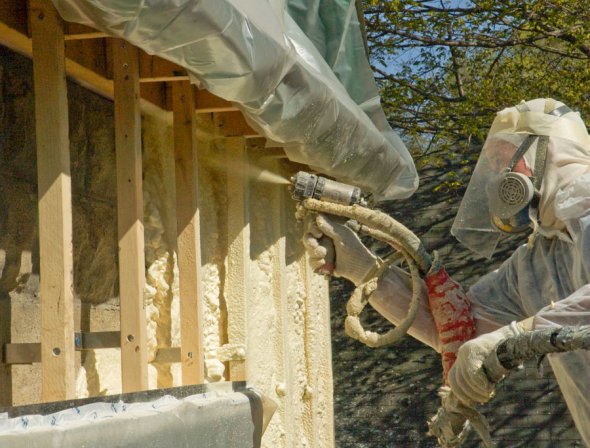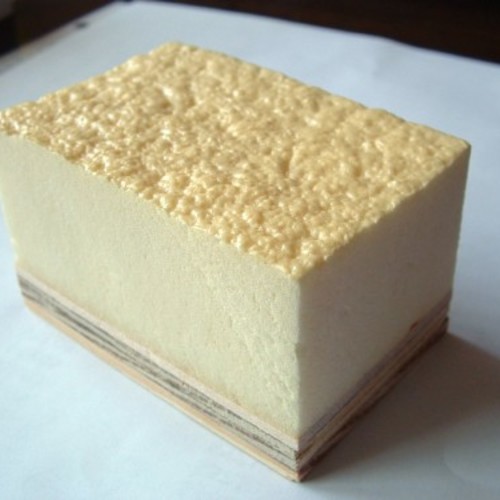
Passive House Institute U.S. has decided to err on the side of environmental caution regarding the global-warming potential of spray foam insulation and the embodied energy of petroleum-based insulation materials in general, according to a recent post by Environmental Building News.
Specifically, PHIUS executive director Katrin Klingenberg told EBN last week that spray polyurethane foam (SPF) insulation using hydrofluorocarbon blowing agents with a high global warming potential would be disallowed on projects seeking certification through the institute’s PHIUS+ program, which was introduced in November and whose full details are due to be finalized by January 1. The no-SPF rule does not apply to most types of open-cell spray foam, and the new rule is optional for projects that had lined up PHIUS pre-certification before November.
PHIUS’s perspective on polyurethane spray foam also will carry over to its examination of and guidance on all insulation materials whose embodied energy is linked to greenhouse gas emissions.
“It does not make any sense at all to use them if one of the major overarching goals of energy conservation in buildings is to counteract and decrease global warming and climate change,” Klingenberg told EBN. “There really is no point to go through all the trouble of detailed Passive House design calculations if you use high-GWP [global-warming potential] spray foam.”
Long-held concerns
In place of spray foam insulation, PHIUS+ will recommend insulation materials with low embodied energy, unless the application is such that no other insulation material will yield the required performance. And while high-density expanded polystyrene is acceptable for below-grade uses, Klingenberg says she prefers the use of cellular glass, such as Foamglas.
SPF has long been seen by some in the building industry as a thorough and effective insulator when applied properly, and by others as a material whose use carries serious risks that extend well beyond the potential for greenhouse gas emissions. Overexposure to the polyisocyanates used in SPF, and in other building materials such as sealants and finishing products, can cause lung damage, trigger an asthmatic attack, or even cause fatal injury.
The potential for health problems among people exposed to uncured polyisocyanates – particularly methelene diphenyl diisocyanate, which is found in a number of consumer and commercial products, and toluene diisocyanate (TDI) – has prompted the Environmental Protection Agency to solicit data on the use of products containing the compounds, which could lead to additional regulations to ensure they’re used safely.
Weekly Newsletter
Get building science and energy efficiency advice, plus special offers, in your inbox.














6 Comments
Worthy sentiment, but
It would be one thing if Passive House certification incorporated a new threshold—via a PHPP calculation—for the aggregate GWP of all the envelope components. But to single out SPF runs counter to the flexible nature of Passive House that empowers designers to experiment with different combinations of components to meet the limits and as such represents a significant erosion of the elegance of the present standard.
Right On!
Finally, an organization with some good information and common sense decision making. No other material besides concrete comes close the global warming potential of closed cell spray foam, and it isn't even in the same ballpark. We should be utilizing cellulose and spun rock insulations in our progressive homes. The home is no place for a chemistry lab experiment.
Briggs makes a good
Briggs makes a good point.
singling out a product and not a certain metric seems questionable. a little 'bad' foam at the hard to detail band joists might not be so bad.
also
would this ban the hand held can forms of spray? what now goes in all the small gaps and cracks?
as far as the chemistry experiment comment... does it matter to the planet whether it occurs at home or at the factory? spun rock is not sourced from the most eco friendly of terms
What did he mean?
What do you mean, " as far as the chemistry experiment comment... does it matter to the planet whether it occurs at home or at the factory? spun rock is not sourced from the most eco friendly of terms"? The fact is, heating rock back to lava and spitting it into fiber does not involve chemistry, but extracting petroleum and altering it chemically to react and create another form does. Closed cell foam uses ozone depleting blowing agents, Roxul does not. Spray foam requires knowledge and how-to to properly mixed components and successfully cure, Roxul does not. Everything we source comes from extraction of minerals from the Earth, but the more natural the material, often the less refinement(along with embodied energy and chemicals) is necessary.
Off-gassing
Indoor air quality from the off gassing of spray foam I foresee as a problem with the ultra-tight, Passivhaus design.
Passive House is a Balanced Building Standard
The Passive House Standard used internationally is a rational and balanced Building standard addressing health, comfort, durability, and energy efficiency as well as sustainability. As such, it permits the use of SPF (closed cell spray polyurethane foam), though it recognizes the concerns motivating PHIUS to ban it.
An example points to the need for balance. I am doing the energy modeling for the deep energy retrofit of an old wooden row house in the often damp climate of San Francisco. It is not possible to air seal or even access the walls adjacent to the houses on either side. In order to air seal and control condensation we are looking at using a 2" layer of SPF in each stud bay with cellulose inside that. This is locally called "Flash and Fill". For more information, see the excellent Building Science Corp report RR-0903 on High-R value walls.
Health Concerns
Right from the start, Health concerns were a clear and important issue for the clients and the building team. One client wrote, "I am not a fan of using petroleum based insulation. However I am particularly adverse to health and durability risks where you cannot see them. Therefore, I can live with using the ecologically flawed technology we have today to ensure I don’t have to remediate an expensive and resource intensive disaster in the future."
GWP?
I did calculate the GWP of using the Flash and fill system. The SPF volume was estimated at 224 cubic ft or 2688 board feet. Using the conversions published in the EBN June 2010 article, the GWP for the SPF is about 24 tonnes CO2. The clients are reducing the operational energy demand from 1530 Therms/yr to about 40 Therms/yr. The equivalent savings in carbon emissions (assuming a 70% gas/30% electricity mix) will be about 468 tonnes CO2 which is 20 times larger than the GWP of the SPF.
I also look forward to the near future when SPF formulations with greatly reduced GWP will be available.
Scott Hunter Ph.D. P.E.
Internationally Certified Passive House Consultant
Certified California Energy Analyst
LEED AP
Log in or create an account to post a comment.
Sign up Log in